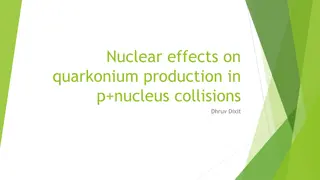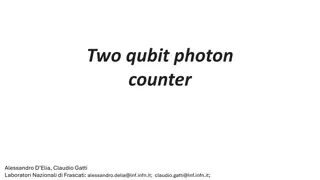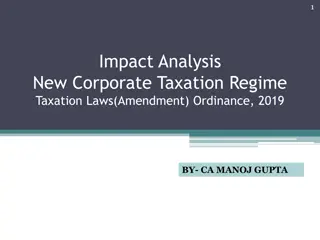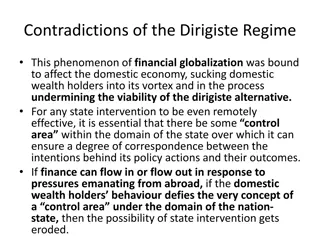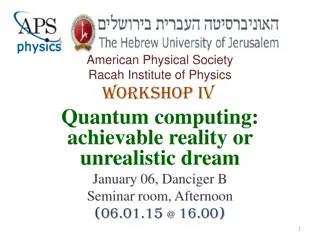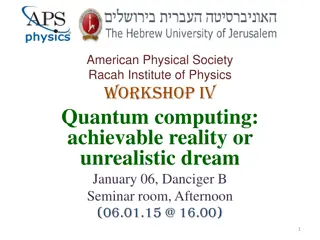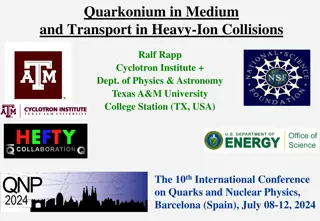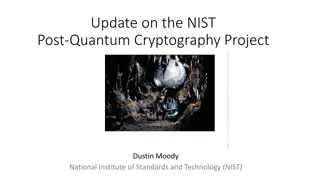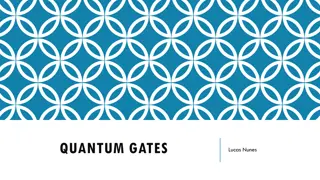Quantum Brownian Regime in Quarkonium Dynamics: Insights and Applications
Exploring quarkonium dynamics in the quantum Brownian regime using non-abelian quantum master equations reveals crucial aspects such as regeneration processes, quarkonia at finite temperature, and distinct regimes based on spectral density and dissociation mechanisms. The study delves into quantum master equations and their implications, shedding light on the correlation with the environment and evolution of the system. Various contributions and typical scenarios in probing URHIC with quarkonia production are discussed, emphasizing the interplay of dilute vs. dense systems, exogenous recombination, and the transition between quantum and semiclassical treatments.
- Quarkonium Dynamics
- Quantum Brownian Regime
- Quantum Master Equations
- Regeneration Processes
- Quarkonia Production
Download Presentation

Please find below an Image/Link to download the presentation.
The content on the website is provided AS IS for your information and personal use only. It may not be sold, licensed, or shared on other websites without obtaining consent from the author. Download presentation by click this link. If you encounter any issues during the download, it is possible that the publisher has removed the file from their server.
E N D
Presentation Transcript
Quarkonium dynamics in the quantum Brownian regime with non-abelian quantum master equations S.Delorme et al. JHEP 06 (2024) 060 Pol B Gossiaux, SUBATECH (NANTES) QNP 7-12 July 2024 Barcelona (Spain) With Aoumeur Daddi Hammou, St phane Delorme, Thierry Gousset, Jean-Paul Blaizot and Pays de la Loire 1
Probing URHIC with quarkonia production 2 typical contributions : primordial B J/ (Re)combination of ? and ? produced in independent initial nucleon-nucleon collisions A Dominant for charmonia production at low pT Early in-medium quarkonia surviving up to the QGP freeze out 2
Regeneration: Dilute vs Dense Bottomia (single pair) Charmonia (many pairs) No exogenous recombination : only the b-bbar pairs which are initially close together will emerge as bottomia states. Exogenous recombination : c & cbar initially far from each other may recombine and emerge as charmonia states No full quantum treatment possible => semi- classical approximation (to be specified later) Full quantum treatment affordable N.B.: In some SC formalisms : intermediate regeneration Level of accuracy ? Structure of the talk 1. Solve the quantum problem in a simple situation (single pair) 2. Use this solution to benchmark the semi-classical approximation 3 Yao, Mehen, M ller (2019)
What is a quarkonia at finite T ? Kim et al, JHEP11(2018)088 Rich structure : broadening and mass shift. What are the underlying ingredients ? 4
Two clear regimes Spectral density T Time Low Temperature High Temperature Dissociation of well identified bound states by scarce high-energy gluons (dilute medium => cross section ok) Multiple scattering on quasi free states Best d.o.f. : individual heavy quarks Best d.o.f. : quarkonia bound states Quantum Brownian Regime Quantum Optical Regime 5
Quantum Master Equations Quite generally, the system builds correlation with the environment thanks to the Hamiltonian Von Neumann equation for the total density operator ? System + environment Evolution of the total system Trace out environment degrees of freedom => Reduced density operator System Evolution of the system Evol. eq. on the red. Density: (linear mapping) However, is generically a non local super-operator in time 6
Non abelian Quantum Master Equation for a ? ? pair 2 coupled color representations (singlet octet) The Linblad Operator contains various terms representing several aspects of HQ physics : kinetic term Unitary dynamics : (screened) real potential term : fluctuations => heating and decoherence Non-Unitary dynamics Imaginary potential W : dissipation : mandatory to preserve positivity (but sub-dominant) 7 J-P.Blaizot & M.A. Escobedo, JHEP 2018.6 (2018)
Further implementation features 1D grid for both and !!! Not the radial decomposition of which is more cumbersome Even states will be considered as S like while odd states will be considered as P like states Need to design a realistic 1D bona fide potential V + i W (based on 3D lQCD results, tuned to reproduce 3D mass spectra and decay widths) T=0.18 T=0.2 T=0.25 T=0.35 T=0.45 T=0.55 8 1D potential from R. Katz, S. Delorme & PBG, Eur. Phys. J. A (2022) 58:198 8
Some selected results for 1 ? ?pair Color Dynamics : Singlet octet probabilities: Starting from a singlet 1S-like, one expects some equilibration / thermalisation -> asymptotic values : o At early times : Quasi exponential behaviour exp(- t/ ), with thermalisation time o< s 2 fm/c o Color appears to thermalize on time scales < QGP life time, but not instantaneoulsy. o C-cbar can interact with the surrounding QGP as an octet => energy loss 9
Evolution of the Density matrix 1S singlet initial state: t=5 fm/c t=0 fm/c T=300 MeV t=20 fm/c t=10 fm/c SC Progressive loss of Q coherence, dissociated component long-lived correlation 10
Evolution of the spatial density 1S singlet initial state: Box : t=0 fm/c singlet octet t=2 fm/c Surviving correlation open HF t=5 fm/c t=10 fm/c t=20 fm/c Some c-cbar stay at intermediate distance ( recombination ) remaining peak in the asymptotic distribution 11
Evolution of the momentum density Convergence -> Maxwellian distribution for p<M, as expected from SC expansion Spurious region for p>M (coming from the mandatory regularization of the imaginary potential room for improvement) Mostly sensitive to the distribution at large relative distance (individual c quarks) 12
Results for projection on vacuum states Starting from a compact S-like state : 1S-like 2S-like 1P-like asympt. Prob. Natural evolution for 1S-like suppression, from low to high T 2S state do not decay ?? 2??at early time partly driven by the ground state at later time. 13
Contact with experiment (??) Bottomonia yield using the QME with EPOS4 (T,v) profiles and starting from a compact ? ? state. 1S suppression : 50% 2S suppression: 95% 3S suppression: 95% (direct production) See Stephane Delorme s talk at SQM24 for more details. 14
Contact with experiment (??) Bottomonia yield using the QME with EPOS4 (T,v) profiles and starting from a compact ? ? state. 1S suppression : 50% 2S suppression: 95% 3S suppression: 95% (direct production) See Stephane Delorme s talk at SQM24 for more details. Similar RAA for Y(3S) and Y(2S) although 3S decay rate >> 2S decay rate . 15
Semiclassical approximation For the relative motion (2 body): and Near thermal equilibrium, Density operator is nearly diagonal => semi-classical expansion of the Linblad equation: power series in y up to 2nd order) Wigner transform : and => Usual Fokker Planck equation : fluctuations dissipation Easy MC implementation + generalization for N body system (c-cbar @ LHC) 16
Concrete implementation 1D (same as for the QME), 1 ? ? pair Same real potential, W in the QME and in the FP Abelian case (for the time, not clear how to deal with the singlet <-> octet transition in a semiclassical approach) Yet, not trivial Initial state vacuum 1S state : 17
Unitary evolution Unitary no fluctuation and dissipation by coupling with the QGP evolution of a vacuum 1S state in a screened V (T=200MeV) still some evolution WQME(t=2fm/c) WSC(t=2fm/c) Normalized to 1 18
Non-unitary evolution Full coupling with the QGP Some specific signs of genuine QM evolution at small time Better agreement between the two descriptions at late times. 19
Non-unitary evolution Full coupling with the QGP III. Late stage evolution: the norm difference d1ceases to decrease and saturates ?! II. Saturation and decrease of the between QME and SC evolution : classicalization I. Growth of the between QME and SC evolution : genuine QM features 20
Non-unitary evolution Full coupling with the QGP Asymptotic III. Late stage evolution: the norm difference d1ceases to decrease and saturates ?! Small deviations of the asymptotic ?2from QME wrt Gibbs- Boltzmann QME Gibbs-Boltzmann II. Saturation and decrease of the between QME and SC evolution : classicalization I. Growth of the between QME and SC evolution : genuine QM features 21
Non-unitary evolution Full coupling with the QGP More concrete observable : Survival probability of the 1S initial state: Good agreement of the SC calculation with the QME benchmark Slight over suppression for the QME (overheating) 22
Non-unitary evolution Full coupling with the QGP More concrete observable : (Re)generate 2S state Good agreement of the SC calculation with the QME benchmark, especially at large T Most significant disagreement for low T, around t = 2.5 fm/c (beginning of the classicalization) 23
Non-unitary evolution Full coupling with the QGP More concrete observable : (Re)generate 2S state Good agreement of the SC calculation with the QME benchmark, especially at large T Higher effect of the genuine interference quantum effects due to the mixture of positive and negative regions in W2S. 24
Conclusions The Lindblad equation succeeds in producing the bottomonia sequential suppression observed in RAA. As next step, we will compute this observable and have direct comparison with experimental data. The semiclassical description reproduces very well the results of the exact quantum description, especially, at high temperatures The late time discrepancies are, mainly, due to the relaxation into different steady states. The steady sate of an open quantum system is still an active research topic ! To come : generalization of the comparison for the non-abelian case. 25
Two types of dynamical modelling (and a 3rd class of its own: statistical hadronization) Quantum Brownian Motion Quantum Optical Regime Well identified resonances Time long enough wrt quantum decoherence time Correlations growing with cooling QGP Best described in position- momentum space Time short wrt quantum decoherence time ? ? Good description with transport models (TAMU, Tsinghua, Duke) Central quantities : 2->2 and 2->3 Cross sections, decay rates Quantum Master Equations for microscopic dof (QS and Qbars) Equilibrium / asympt* : some limiting cases Equilibrium : exp(-En/T) (theorem) SC Approx: Fokker-Planck equations in position-momentum space SC Approx: rate equations * Since one is facing both dissociation and recombination, obtaining a correct equilibrium limit of these model is an important prerequisite !!! 27
Pictorial summary Inspired from Yao Int. J. of Mod. Phys. A, Vol. 36, No. 20, 2130010 (2021) E: environment autocorrelation time S: system intrinsic time scale R: system relaxation time Weak syst-environment coupling + Markovian limit Smallest time scales wins it all ! Redfield equation Quantum Optical Regime Quantum Brownian Motion Not the same basis ! Eigenstates of the HQ Hamiltonian Phase space densities Rate equations: transport models Semi-classical approx : density matrix diagonal Good method for many ? ? pairs 28
Two types of dynamical modelling Tov. damp QOR QBM Numbers extracted from potential described in Phys. Rev. D 101, 056010 (2020) 29
QED-like vs genuine QCD case Genuine QCD QED-like Scattering from gluons change the color respresentation : o <-> s Scattering from photons do not change the Casimir : s <-> s No binding potential in the octet chanel => large energy gap Usual 1S <-> 1P transitions between bound states. 30
Quantum vs SC dynamics SCA : linear mapping - - - Fokker-Planck/Langevin Always positive defined even if Winand Wfinare not positive defined Several aspects : o Temperature o Initial state o Property considered In the following : only a limited set of results; manuscript to come soon First looking at global difference : 33
Quantum vs SC dynamics (QED-like) More local quantities: <p2> vs r (in the Wigner sense) Nearly perfect agreement at large distance More structure seen in the genuine QM calculation at close ccbar distance 35
Asymptotic distributions / quarkonium weights First, looking at the QED-like case. 60 fm/c In the simulation, some peak survives in the density, at small distance This peak is in direct correlation with the charmonium weight The asymptotic states may not be reached in realistic AA collisions, but controlling/understanding them is important : o Sanity check of the models o Privileged link with lQCD spectral distribution (evaluated in this limit) 37
Asymptotic distribution: QED-like First, looking at the QED-like case. Even simpler case : Semi classical approximation : (Wigner representation) 2 lines calculation : 38
Asymptotic distribution: QED-like First, looking at the QED-like case. Even simpler case : Semi classical approximation : (Wigner representation) r(fm-1) T=0.2 GeV QME QME SCA r(fm) Peak, independently of box size Pretty well described by SC relation (apart around the origin): 39
Quarkonium-like weights First, looking at the QED-like case. Boltzmann : SCA : Local states Boltzmann QBM QOR Good agreement between QME & SC in the deep QBM regime (expected) Good agreement between QME & Boltzmann Ansatz, even in the QOR !!! Not expected at all. SCA : not succesfull for 1P-like state 40
Asymptotic distribution: QCD Now the genuine QCD case Solving With thermalized Ansatz for Do The peak around origin is reduced in the case of QCD ! Quarks more deconfined than in QED-like case. Reminder : discussion specific to the QBM regime (not the QOR) 41
Asymptotic distribution: QCD A possible physical explanation Loss singlet singlet QED like : 1S P states Gain As the binding potential also acts on P-states (singlet), both densities can increase together when a real potential is applied (gain and loss terms keep ) Loss octet singlet QCD : 1S P states Gain << As there is no potential in the octet chanel, the Q and Qbar quarks have a tendancy to fly apart fast (the asymtotic octet density is found indeed flat). Hence, the gain term does not increase to the loss term and the equilibrium limit is displaced wrt QED-like 42
Quarkonium weights And of course, a lot of questions o Is this result correct or the sign of some illness in the QME ? (or the author s mind) o Can this result be understood by rephrasing things with usual rate equation ? o Can we put some mathematical modelling on it ? 43











